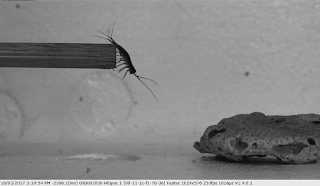Evolution of bipedal running
 |
| Awesome lizard shot by Simon Pynt which sadly the journal did not want on its cover |
This week my paper on the evolution of bipedalism came out in the journal
Evolution. This work is part of a long ongoing project understanding why these
lizards sometimes run on two legs and sometimes run on four, and why Australian
agamid lizards in particular seem to be so very good at the former. But to
understand this we need a little bit of background into Bipedalism and why
lizards are so weird.
 |
| Awesome picture of a dinosaur I stole from the web. To make this blog post look cooler. |
Bipedalism
(running on two legs) evolved independently many times, for example in hopping
marsupials (like kangaroos), hopping placentals (like kangaroo rats), primates
(like us), birds, dinosaurs, lizards, insects, and this awesome octopus! In birds,
primates and dinosaurs the forelimbs appear to be used for something else so
bipedalism makes sense, and hopping on two legs can save energy, but neither of
these reasons seem to apply to lizards. Further I showed in an earlier paper
that bipedal lizards are not faster, nor can they run for longer. So why are
they doing it?
Well a dutch researcher called Peter Aerts actually suggested a different
reason. Perhaps, he suggested, lizards were not trying to run bipedally on
purpose, but rather they were trying to do something else, maybe they were
trying to become more manoeuvrable. One way to become more manoeuvrable, is to
shift all your mass backwards (which makes it easier to turn corners), and then
accelerate quickly. Unfortunately for the lizards these things have a side
effect, just like when a motorcycle accelerates too quickly, when a lizard
shifts its mass backwards and accelerates too quickly, it can cause the front
of the body to pop up, like its popping a wheelie. Seen in this light,
bipedalism in some lizards might have been an accident, just a consequence of
accelerating too hard, and this seems to match some of the data I have
collected before on lizards. There is certainly an acceleration threshold where
a lizard will pop on its two back legs, and a model produced by Peter Aerts
even predicts when this should happen. And this model matches the data, for
most lizards.
 |
| Another awesome dinosaur photo i stole from the web. Geez these dinosaurs would have been so bad ass! |
The trouble is that some lizards seem to beat the model. Some lizards
seem to be able to run for much longer and at lower accelerations than is
predicted from this accidental model. Are these lizards exploiting bipedalism?
taking advantage of the accident? This is actually not so unheard of in nature,
infact it’s common enough that scientists gave it a name, they called it an
Exaptation (to differentiate it from the perhaps more familiar adaptation).
Exaptations are exciting since they show us another way traits can evolve.
Infact one of the most common examples of exaptation is the evolution of
feathers in birds. Feathers, which we now commonly associate with flight in
birds, did not originally evolve for this purpose. Lots of recent reports have
shown us that the origin of feathers predates that of birds and are present in
dinosaurs, meaning feathers probably evolved for another reason, like keeping
dinosaurs warm. It was only later that birds exploited these feathers to make their
remarkable flying wings. So could bipedalism, like the feathers of birds, be an
exaptation? This is what I set out to find.
 |
| Figure showing the evolution of the mass distribution among lizards. Red means a backwards shift, blue forwards. The bipedal lizards are marked with a red box. |
First I had to know, do lizards (and their ancestors) which run bipedally
have their body mass pushed backwards, perhaps to try and become more manoeuvrable?
I looked at this across 124 species of lizards, basically any lizard I could
get my hands on from the Queensland museum, with the help of my student at the
time Nicolas Wu, and I found yes indeed, the lineages leading to bipedalism had
shifted their body centre of mass backwards.
Next I tested the model, I calculated (based on Aerts’ model) when
lizards should go bipedal, and then ran these lizards a bunch of times to
calculate the exact acceleration where they switched from four legs to two
legs. As predicted some lizards matched the model quite well, but others were
able to beat it, running bipedally sooner than expected.
 |
| This is one of the rare videos i got of a lizard transitioning from 4 legs to 2! |
 Finally we looked at where these differences
are greatest in the family tree of Australian agamids. We found the ones that
matched the model best occurred very early on in the evolutionary tree, but as
the tree branched out the differences became greater. New species were beating
the model more and more. All this adds up to one thing, an exaptation. Bipedalism
first appeared on the scene a long time ago, and those that ran bipedally did
so only by accident. But at some point some lizards started exploiting this,
running bipedally further and more often than expected, taking advantage of the
consequence. This is exciting since not only are we seeing an exaptation
happen, but it means that running on two lizards actually conveys an advantage
to these lizards. Just what this advantage is thought, I have no idea…yet.
Finally we looked at where these differences
are greatest in the family tree of Australian agamids. We found the ones that
matched the model best occurred very early on in the evolutionary tree, but as
the tree branched out the differences became greater. New species were beating
the model more and more. All this adds up to one thing, an exaptation. Bipedalism
first appeared on the scene a long time ago, and those that ran bipedally did
so only by accident. But at some point some lizards started exploiting this,
running bipedally further and more often than expected, taking advantage of the
consequence. This is exciting since not only are we seeing an exaptation
happen, but it means that running on two lizards actually conveys an advantage
to these lizards. Just what this advantage is thought, I have no idea…yet. 



Comments
Post a Comment